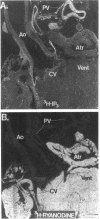Abstract
Calcium-induced calcium release (CICR) pools have been demonstrated in brain and heart microsomes biochemically and autoradiographically by the sensitivity of 45Ca2+ accumulation to Mg2+, ATP, ruthenium red, caffeine, and tetracaine. The CICR pool colocalizes with [3H]ryanodine binding sites, supporting the notion that [3H]ryanodine labels CICR pools. Sites of CICR pools in the brain contrast with those of inositol 1,4,5-trisphosphate (IP3)-sensitive Ca2+ pools with reciprocal localizations between the two Ca2+ pools in several structures. Thus, in the hippocampus CA-1 is enriched in IP3-sensitive Ca2+ pools, whereas CICR pools are highest in CA-3 and the dentate gyrus. The corpus striatum and cerebellum are enriched in IP3 pools, whereas the medial septum and olfactory bulb have high CICR densities. In cardiac tissue, CICR is localized to atrial and ventricular muscle, whereas IP3 pools are concentrated in coronary vessels and cardiac conduction fibers. The reciprocal enrichment of IP3 and CICR Ca2+ pools implies differential regulation of Ca2+ hemostasis in these tissues.
Full text
PDF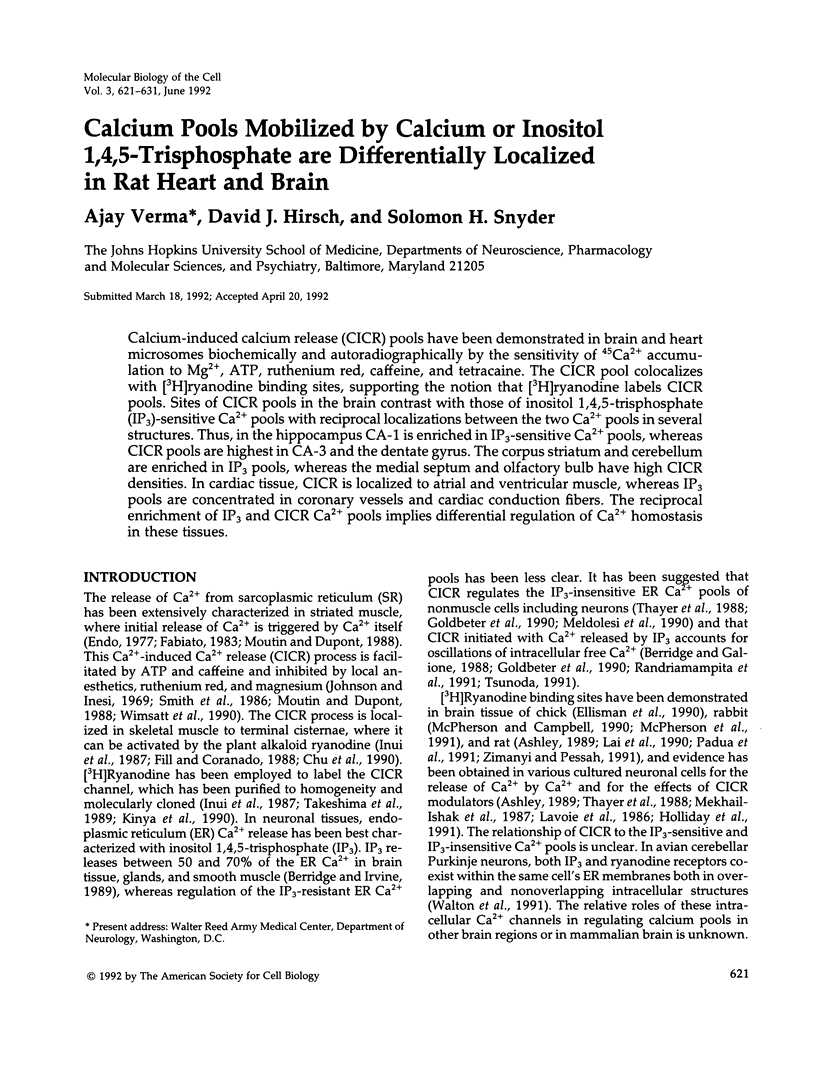
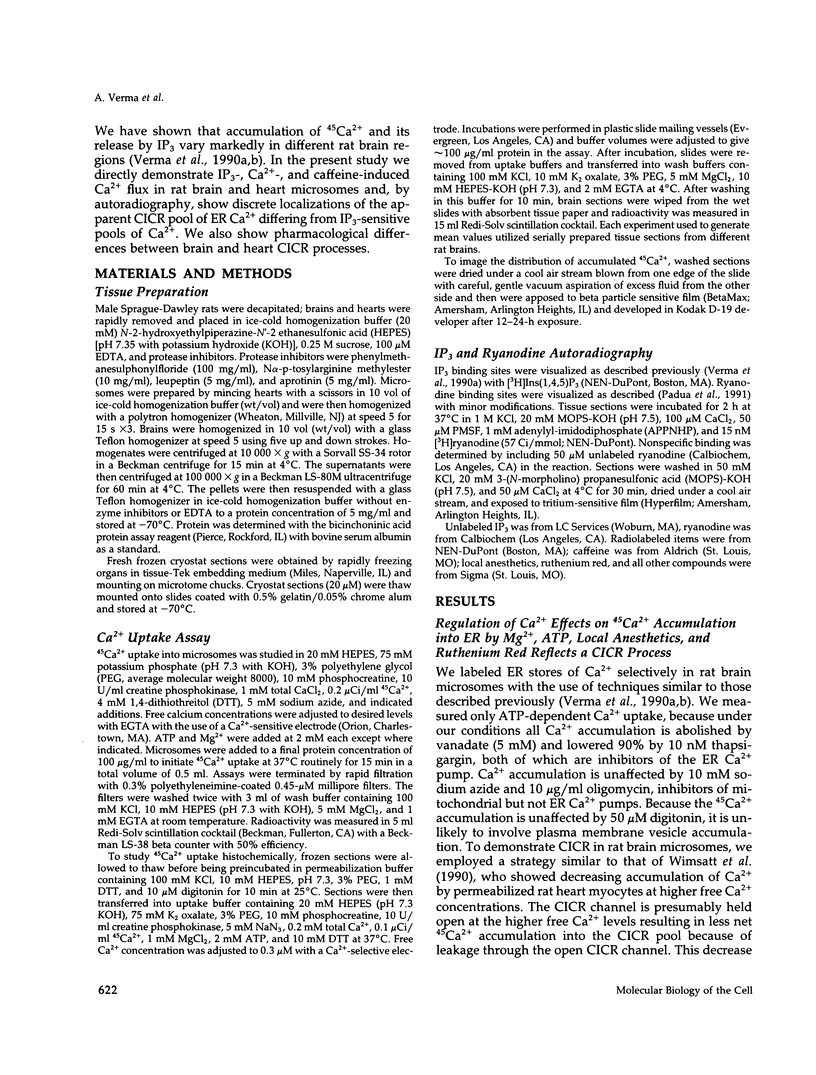
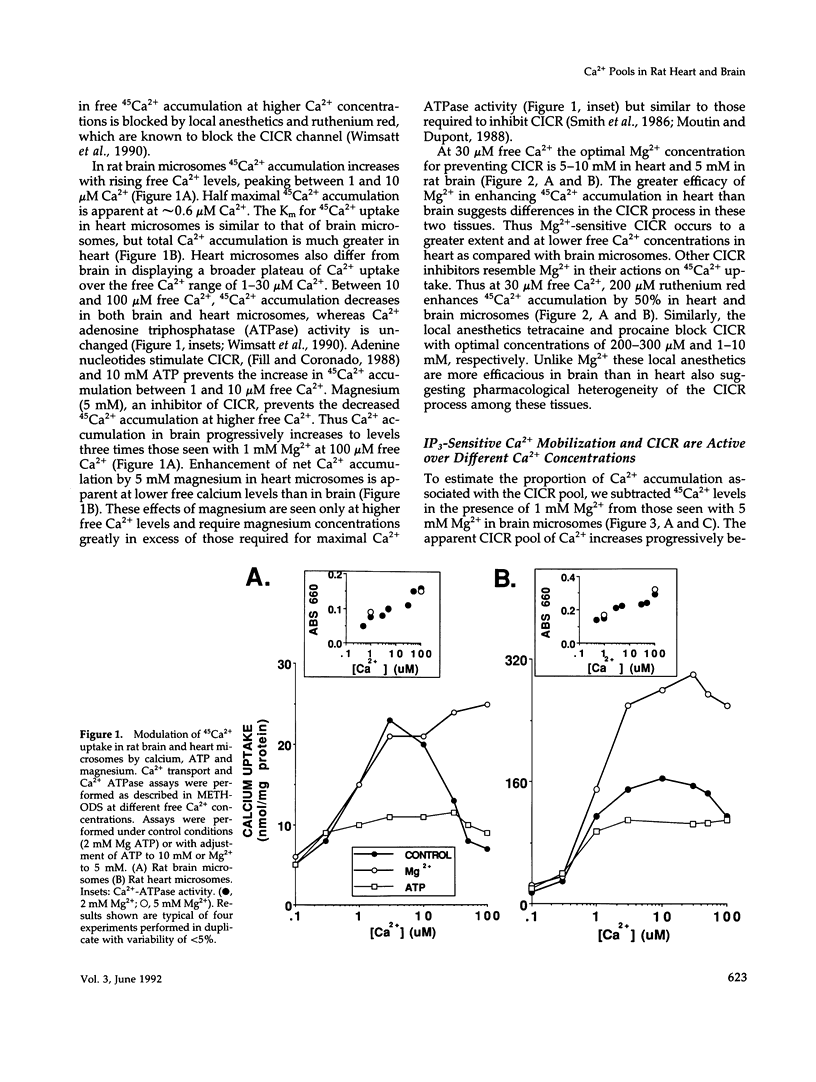
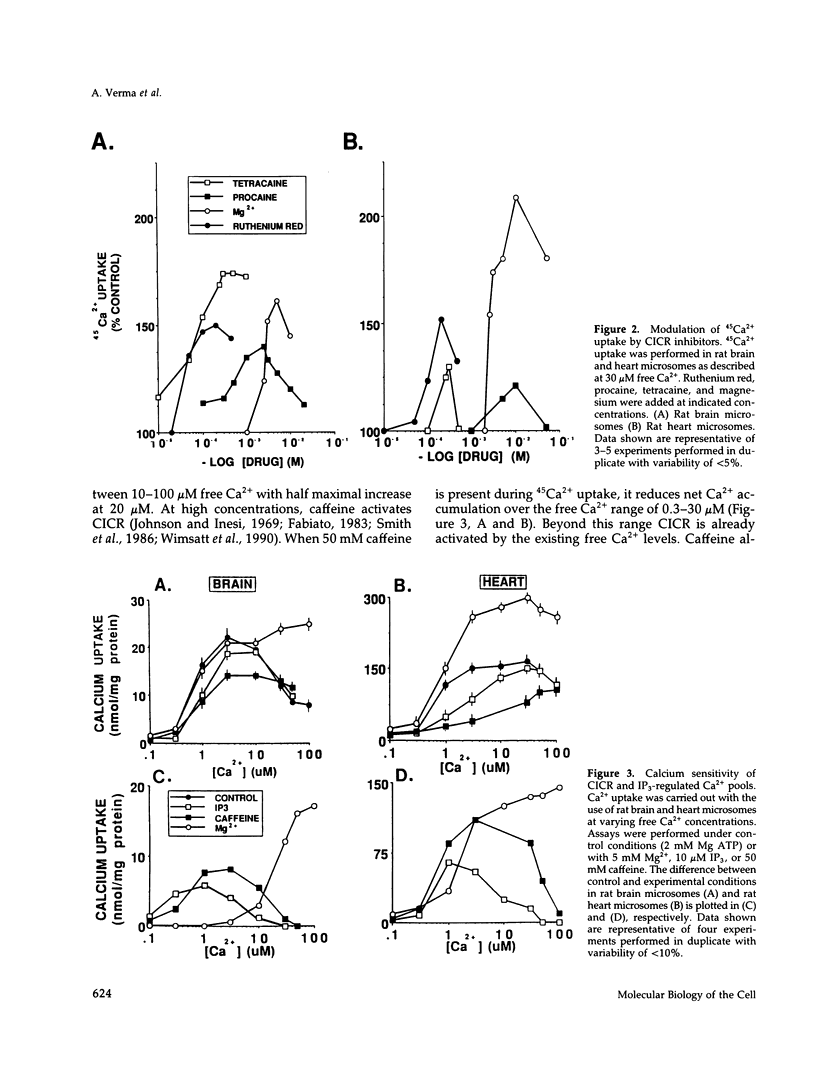
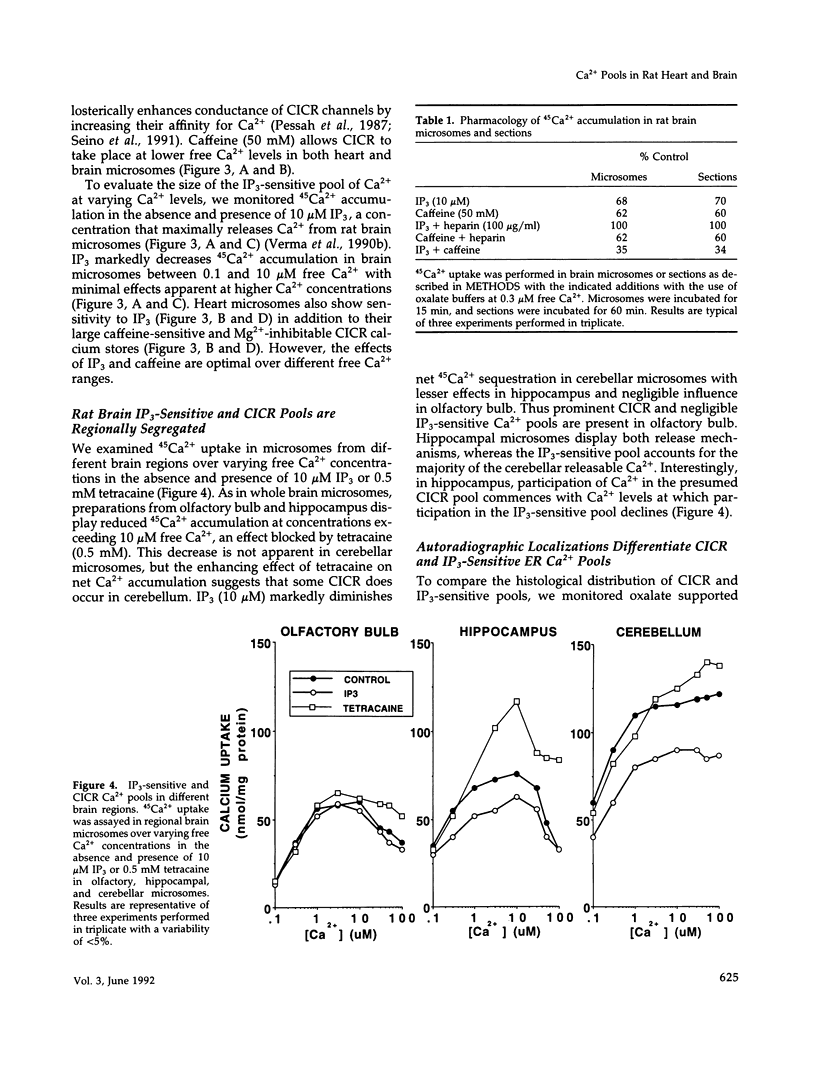
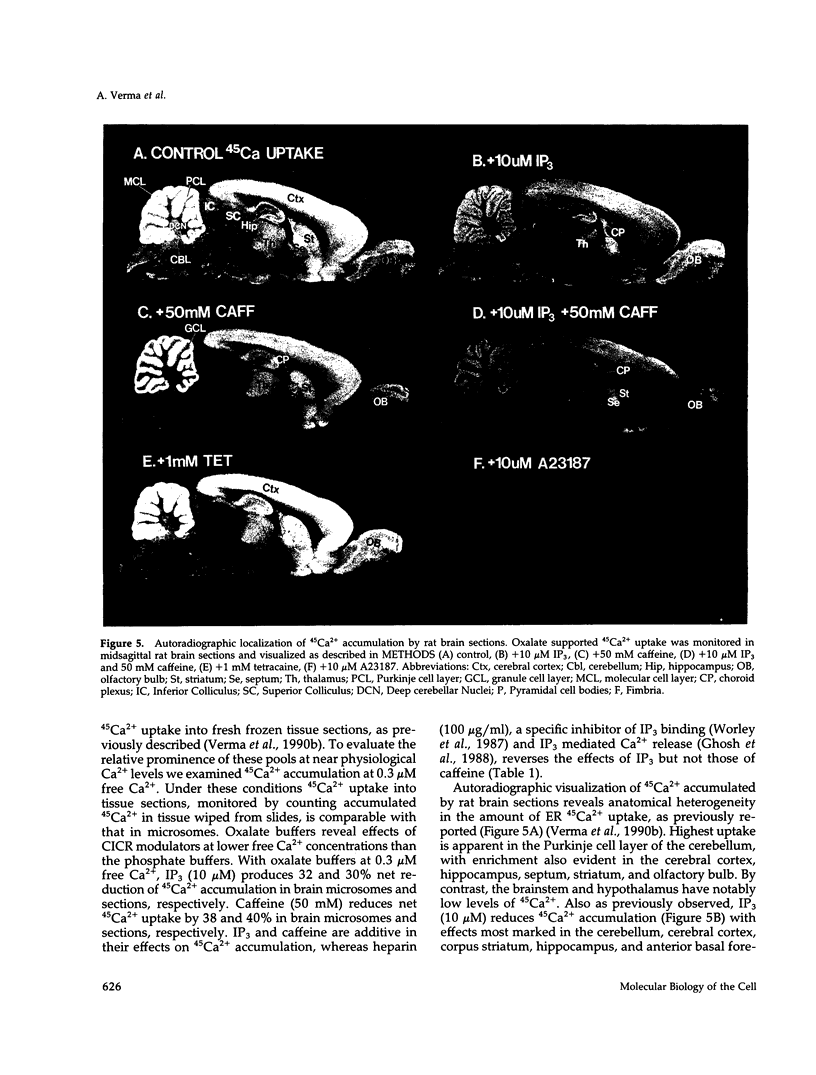
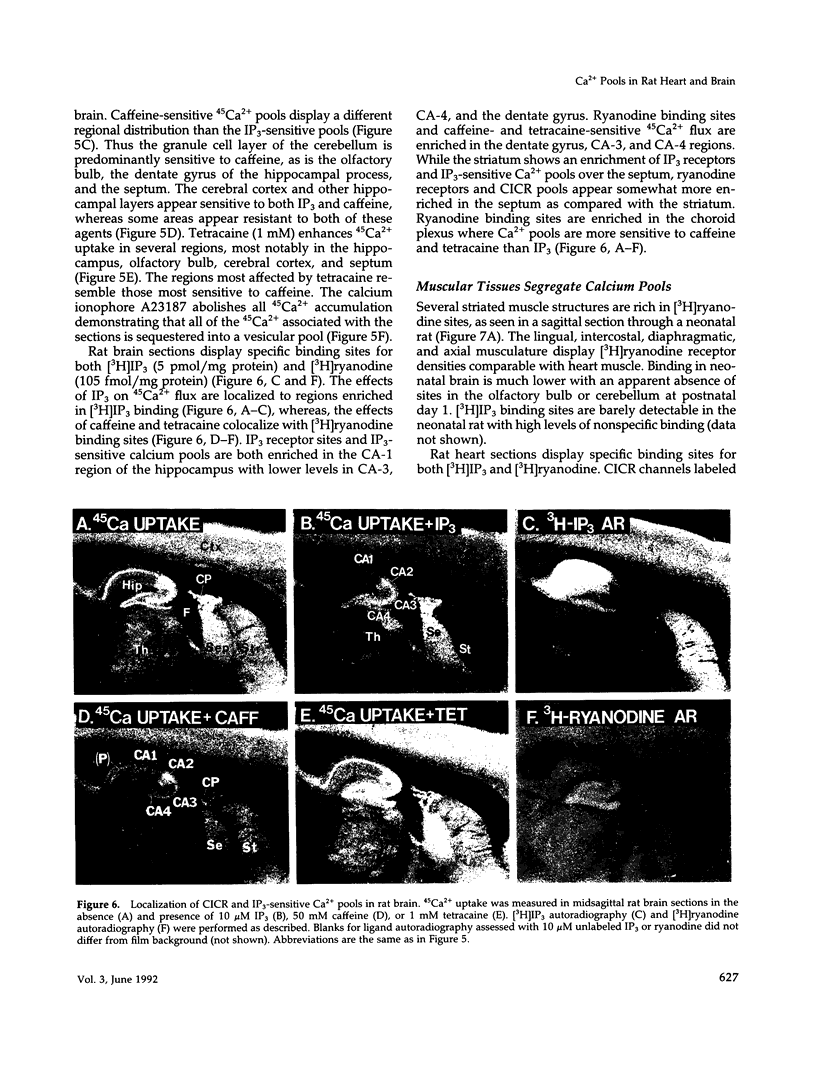
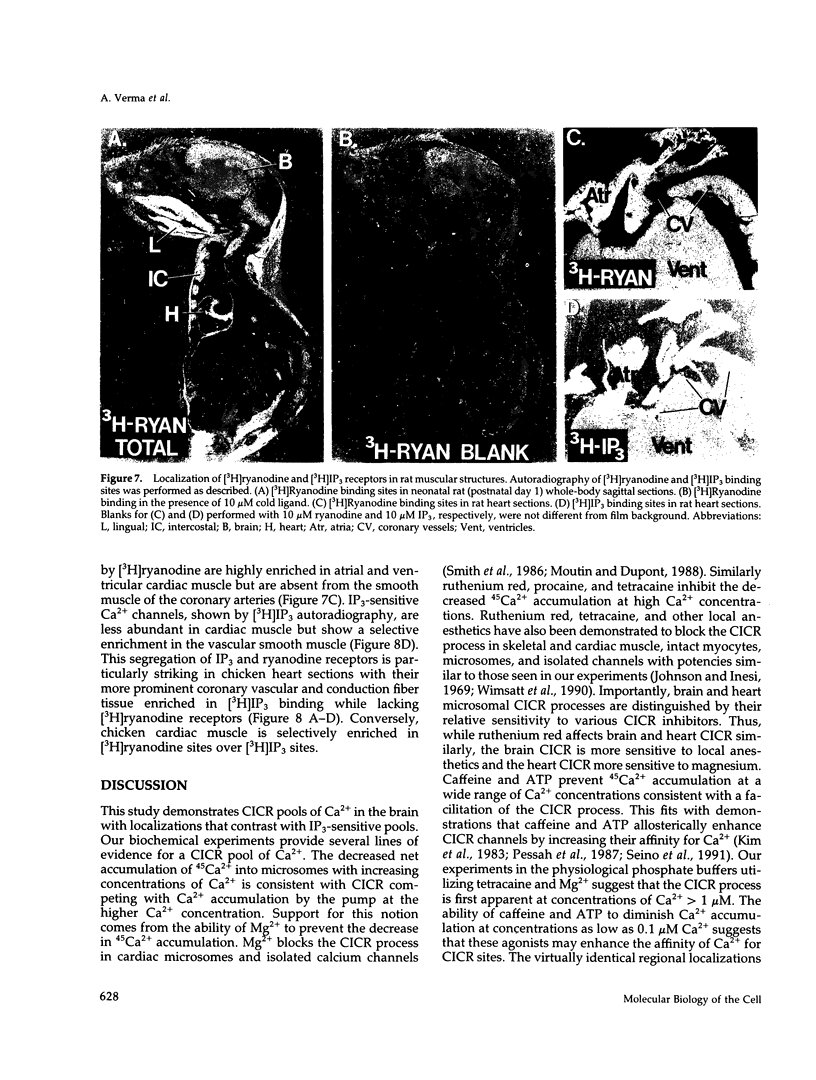
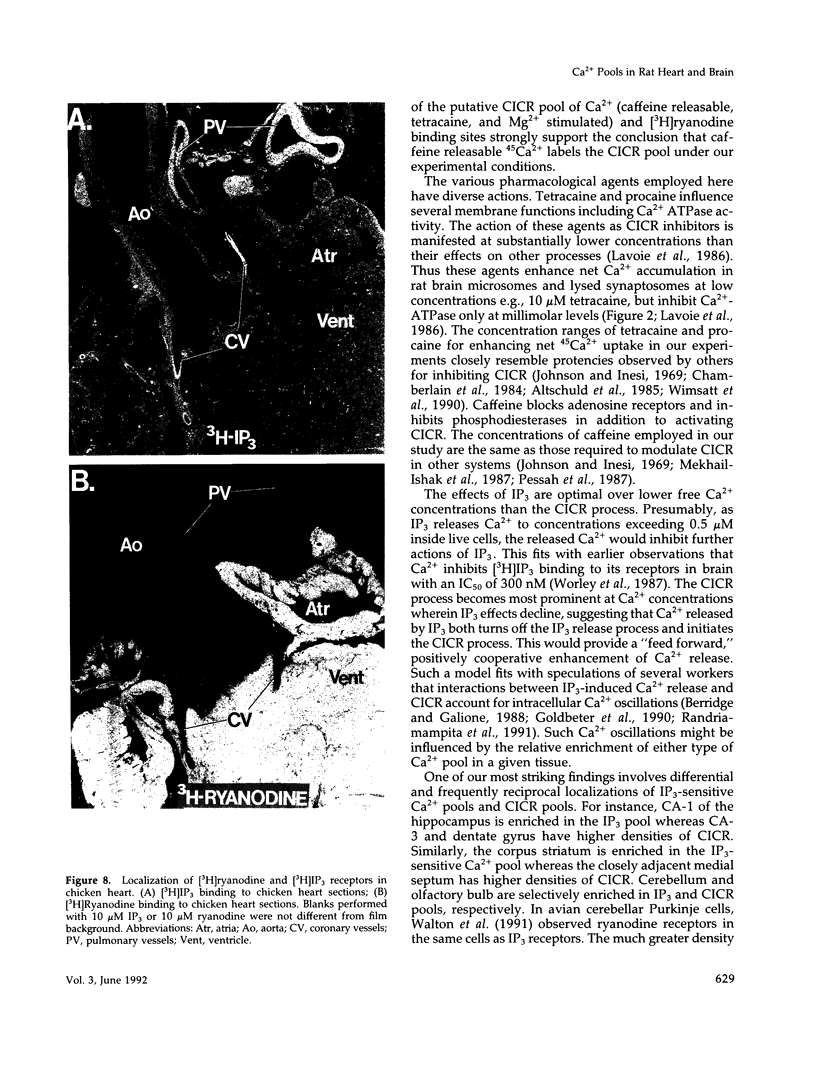
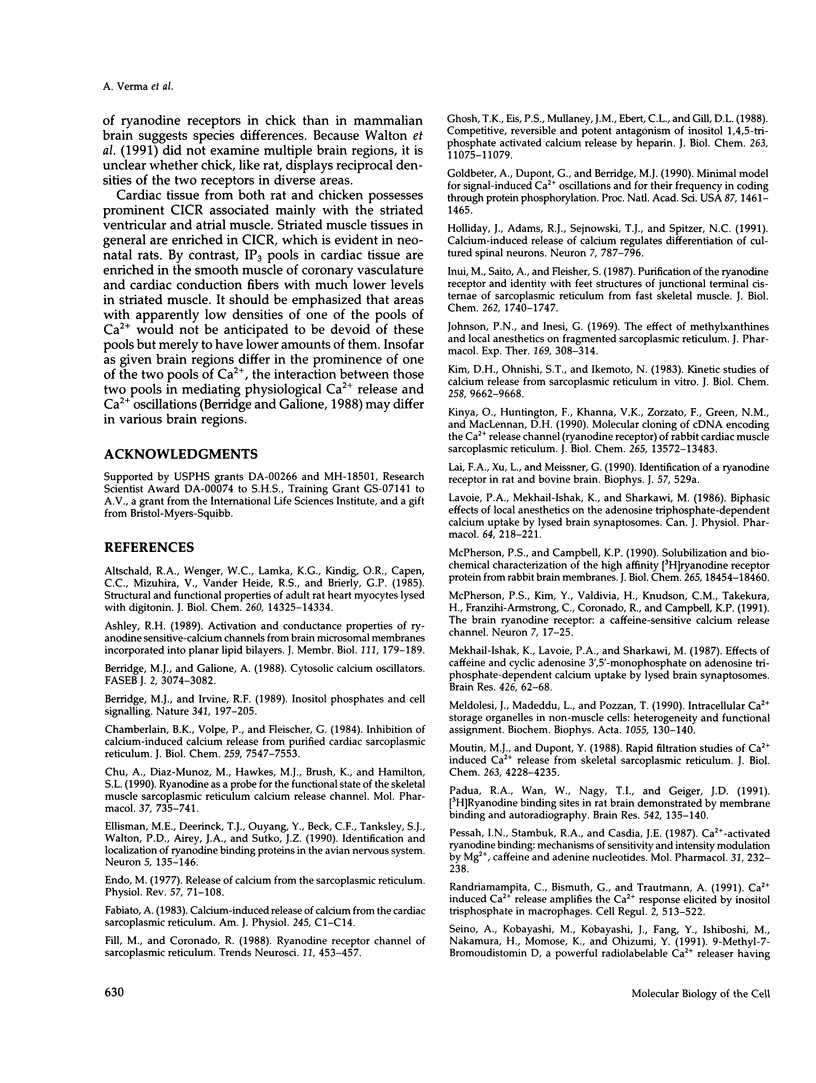
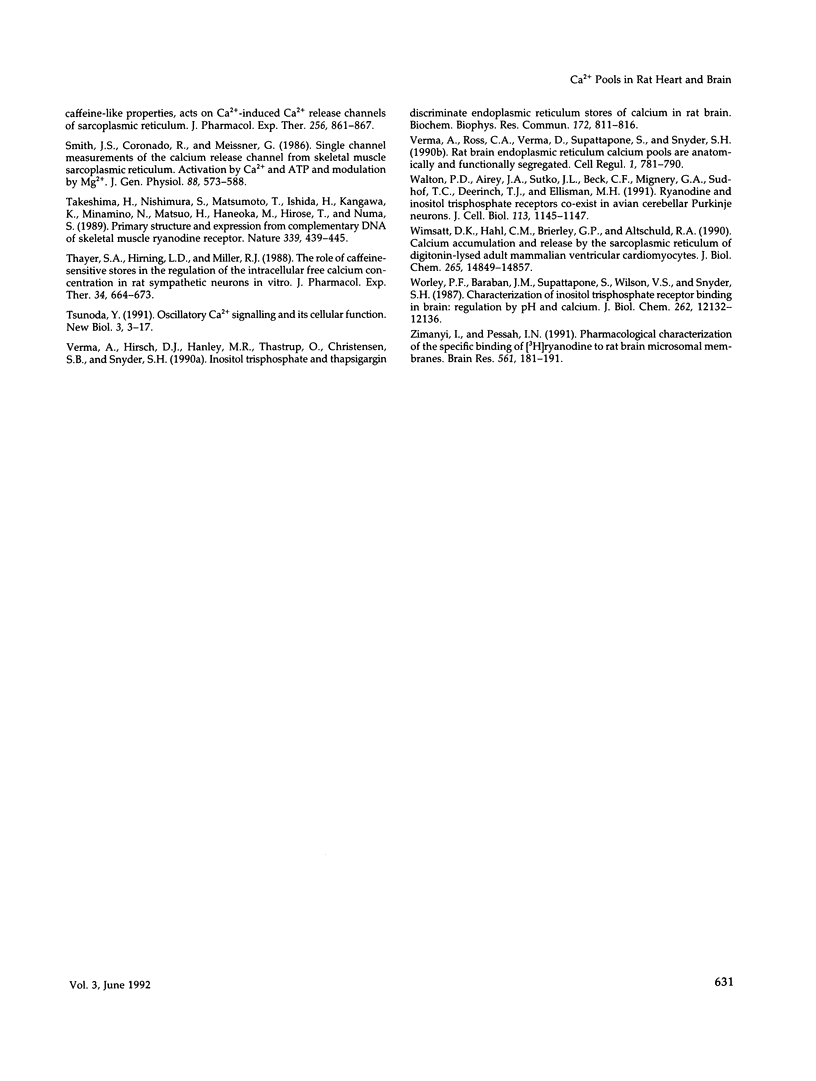
Images in this article
Selected References
These references are in PubMed. This may not be the complete list of references from this article.
- Altschuld R. A., Wenger W. C., Lamka K. G., Kindig O. R., Capen C. C., Mizuhira V., Vander Heide R. S., Brierley G. P. Structural and functional properties of adult rat heart myocytes lysed with digitonin. J Biol Chem. 1985 Nov 15;260(26):14325–14334. [PubMed] [Google Scholar]
- Ashley R. H. Activation and conductance properties of ryanodine-sensitive calcium channels from brain microsomal membranes incorporated into planar lipid bilayers. J Membr Biol. 1989 Oct;111(2):179–189. doi: 10.1007/BF01871781. [DOI] [PubMed] [Google Scholar]
- Berridge M. J., Galione A. Cytosolic calcium oscillators. FASEB J. 1988 Dec;2(15):3074–3082. doi: 10.1096/fasebj.2.15.2847949. [DOI] [PubMed] [Google Scholar]
- Berridge M. J., Irvine R. F. Inositol phosphates and cell signalling. Nature. 1989 Sep 21;341(6239):197–205. doi: 10.1038/341197a0. [DOI] [PubMed] [Google Scholar]
- Chamberlain B. K., Volpe P., Fleischer S. Inhibition of calcium-induced calcium release from purified cardiac sarcoplasmic reticulum vesicles. J Biol Chem. 1984 Jun 25;259(12):7547–7553. [PubMed] [Google Scholar]
- Chu A., Díaz-Muñoz M., Hawkes M. J., Brush K., Hamilton S. L. Ryanodine as a probe for the functional state of the skeletal muscle sarcoplasmic reticulum calcium release channel. Mol Pharmacol. 1990 May;37(5):735–741. [PubMed] [Google Scholar]
- Ellisman M. H., Deerinck T. J., Ouyang Y., Beck C. F., Tanksley S. J., Walton P. D., Airey J. A., Sutko J. L. Identification and localization of ryanodine binding proteins in the avian central nervous system. Neuron. 1990 Aug;5(2):135–146. doi: 10.1016/0896-6273(90)90304-x. [DOI] [PubMed] [Google Scholar]
- Endo M. Calcium release from the sarcoplasmic reticulum. Physiol Rev. 1977 Jan;57(1):71–108. doi: 10.1152/physrev.1977.57.1.71. [DOI] [PubMed] [Google Scholar]
- Fabiato A. Calcium-induced release of calcium from the cardiac sarcoplasmic reticulum. Am J Physiol. 1983 Jul;245(1):C1–14. doi: 10.1152/ajpcell.1983.245.1.C1. [DOI] [PubMed] [Google Scholar]
- Fill M., Coronado R. Ryanodine receptor channel of sarcoplasmic reticulum. Trends Neurosci. 1988 Oct;11(10):453–457. doi: 10.1016/0166-2236(88)90198-1. [DOI] [PubMed] [Google Scholar]
- Ghosh T. K., Eis P. S., Mullaney J. M., Ebert C. L., Gill D. L. Competitive, reversible, and potent antagonism of inositol 1,4,5-trisphosphate-activated calcium release by heparin. J Biol Chem. 1988 Aug 15;263(23):11075–11079. [PubMed] [Google Scholar]
- Goldbeter A., Dupont G., Berridge M. J. Minimal model for signal-induced Ca2+ oscillations and for their frequency encoding through protein phosphorylation. Proc Natl Acad Sci U S A. 1990 Feb;87(4):1461–1465. doi: 10.1073/pnas.87.4.1461. [DOI] [PMC free article] [PubMed] [Google Scholar]
- Holliday J., Adams R. J., Sejnowski T. J., Spitzer N. C. Calcium-induced release of calcium regulates differentiation of cultured spinal neurons. Neuron. 1991 Nov;7(5):787–796. doi: 10.1016/0896-6273(91)90281-4. [DOI] [PubMed] [Google Scholar]
- Inui M., Saito A., Fleischer S. Purification of the ryanodine receptor and identity with feet structures of junctional terminal cisternae of sarcoplasmic reticulum from fast skeletal muscle. J Biol Chem. 1987 Feb 5;262(4):1740–1747. [PubMed] [Google Scholar]
- Johnson P. N., Inesi G. The effect of methylxanthines and local anesthetics on fragmented sarcoplasmic reticulum. J Pharmacol Exp Ther. 1969 Oct;169(2):308–314. [PubMed] [Google Scholar]
- Kim D. H., Ohnishi S. T., Ikemoto N. Kinetic studies of calcium release from sarcoplasmic reticulum in vitro. J Biol Chem. 1983 Aug 25;258(16):9662–9668. [PubMed] [Google Scholar]
- Lavoie P. A., Mekhail-Ishak K., Sharkawi M. Biphasic effect of local anesthetics on the adenosine triphosphate-dependent calcium uptake by lysed brain synaptosomes. Can J Physiol Pharmacol. 1986 Feb;64(2):218–221. doi: 10.1139/y86-033. [DOI] [PubMed] [Google Scholar]
- McPherson P. S., Campbell K. P. Solubilization and biochemical characterization of the high affinity [3H]ryanodine receptor from rabbit brain membranes. J Biol Chem. 1990 Oct 25;265(30):18454–18460. [PubMed] [Google Scholar]
- McPherson P. S., Kim Y. K., Valdivia H., Knudson C. M., Takekura H., Franzini-Armstrong C., Coronado R., Campbell K. P. The brain ryanodine receptor: a caffeine-sensitive calcium release channel. Neuron. 1991 Jul;7(1):17–25. doi: 10.1016/0896-6273(91)90070-g. [DOI] [PubMed] [Google Scholar]
- Mekhail-Ishak K., Lavoie P. A., Sharkawi M. Effects of caffeine and cyclic adenosine 3',5'-monophosphate on adenosine triphosphate-dependent calcium uptake by lysed brain synaptosomes. Brain Res. 1987 Nov 17;426(1):62–68. doi: 10.1016/0006-8993(87)90425-2. [DOI] [PubMed] [Google Scholar]
- Meldolesi J., Madeddu L., Pozzan T. Intracellular Ca2+ storage organelles in non-muscle cells: heterogeneity and functional assignment. Biochim Biophys Acta. 1990 Nov 12;1055(2):130–140. doi: 10.1016/0167-4889(90)90113-r. [DOI] [PubMed] [Google Scholar]
- Moutin M. J., Dupont Y. Rapid filtration studies of Ca2+-induced Ca2+ release from skeletal sarcoplasmic reticulum. Role of monovalent ions. J Biol Chem. 1988 Mar 25;263(9):4228–4235. [PubMed] [Google Scholar]
- Otsu K., Willard H. F., Khanna V. K., Zorzato F., Green N. M., MacLennan D. H. Molecular cloning of cDNA encoding the Ca2+ release channel (ryanodine receptor) of rabbit cardiac muscle sarcoplasmic reticulum. J Biol Chem. 1990 Aug 15;265(23):13472–13483. [PubMed] [Google Scholar]
- Padua R. A., Wan W. H., Nagy J. I., Geiger J. D. [3H]ryanodine binding sites in rat brain demonstrated by membrane binding and autoradiography. Brain Res. 1991 Feb 22;542(1):135–140. doi: 10.1016/0006-8993(91)91007-n. [DOI] [PubMed] [Google Scholar]
- Pessah I. N., Stambuk R. A., Casida J. E. Ca2+-activated ryanodine binding: mechanisms of sensitivity and intensity modulation by Mg2+, caffeine, and adenine nucleotides. Mol Pharmacol. 1987 Mar;31(3):232–238. [PubMed] [Google Scholar]
- Randriamampita C., Bismuth G., Trautmann A. Ca(2+)-induced Ca2+ release amplifies the Ca2+ response elicited by inositol trisphosphate in macrophages. Cell Regul. 1991 Jul;2(7):513–522. doi: 10.1091/mbc.2.7.513. [DOI] [PMC free article] [PubMed] [Google Scholar]
- Seino A., Kobayashi M., Kobayashi J., Fang Y. I., Ishibashi M., Nakamura H., Momose K., Ohizumi Y. 9-methyl-7-bromoeudistomin D, a powerful radio-labelable Ca++ releaser having caffeine-like properties, acts on Ca(++)-induced Ca++ release channels of sarcoplasmic reticulum. J Pharmacol Exp Ther. 1991 Mar;256(3):861–867. [PubMed] [Google Scholar]
- Smith J. S., Coronado R., Meissner G. Single channel measurements of the calcium release channel from skeletal muscle sarcoplasmic reticulum. Activation by Ca2+ and ATP and modulation by Mg2+. J Gen Physiol. 1986 Nov;88(5):573–588. doi: 10.1085/jgp.88.5.573. [DOI] [PMC free article] [PubMed] [Google Scholar]
- Takeshima H., Nishimura S., Matsumoto T., Ishida H., Kangawa K., Minamino N., Matsuo H., Ueda M., Hanaoka M., Hirose T. Primary structure and expression from complementary DNA of skeletal muscle ryanodine receptor. Nature. 1989 Jun 8;339(6224):439–445. doi: 10.1038/339439a0. [DOI] [PubMed] [Google Scholar]
- Thayer S. A., Hirning L. D., Miller R. J. The role of caffeine-sensitive calcium stores in the regulation of the intracellular free calcium concentration in rat sympathetic neurons in vitro. Mol Pharmacol. 1988 Nov;34(5):664–673. [PubMed] [Google Scholar]
- Tsunoda Y. Oscillatory Ca2+ signaling and its cellular function. New Biol. 1991 Jan;3(1):3–17. [PubMed] [Google Scholar]
- Verma A., Hirsch D. J., Hanley M. R., Thastrup O., Christensen S. B., Snyder S. H. Inositol trisphosphate and thapsigargin discriminate endoplasmic reticulum stores of calcium in rat brain. Biochem Biophys Res Commun. 1990 Oct 30;172(2):811–816. doi: 10.1016/0006-291x(90)90747-b. [DOI] [PubMed] [Google Scholar]
- Verma A., Ross C. A., Verma D., Supattapone S., Snyder S. H. Rat brain endoplasmic reticulum calcium pools are anatomically and functionally segregated. Cell Regul. 1990 Sep;1(10):781–790. doi: 10.1091/mbc.1.10.781. [DOI] [PMC free article] [PubMed] [Google Scholar]
- Walton P. D., Airey J. A., Sutko J. L., Beck C. F., Mignery G. A., Südhof T. C., Deerinck T. J., Ellisman M. H. Ryanodine and inositol trisphosphate receptors coexist in avian cerebellar Purkinje neurons. J Cell Biol. 1991 Jun;113(5):1145–1157. doi: 10.1083/jcb.113.5.1145. [DOI] [PMC free article] [PubMed] [Google Scholar]
- Wimsatt D. K., Hohl C. M., Brierley G. P., Altschuld R. A. Calcium accumulation and release by the sarcoplasmic reticulum of digitonin-lysed adult mammalian ventricular cardiomyocytes. J Biol Chem. 1990 Sep 5;265(25):14849–14857. [PubMed] [Google Scholar]
- Worley P. F., Baraban J. M., Supattapone S., Wilson V. S., Snyder S. H. Characterization of inositol trisphosphate receptor binding in brain. Regulation by pH and calcium. J Biol Chem. 1987 Sep 5;262(25):12132–12136. [PubMed] [Google Scholar]
- Zimanyi I., Pessah I. N. Pharmacological characterization of the specific binding of [3H]ryanodine to rat brain microsomal membranes. Brain Res. 1991 Oct 11;561(2):181–191. doi: 10.1016/0006-8993(91)91594-q. [DOI] [PubMed] [Google Scholar]






